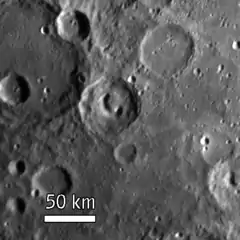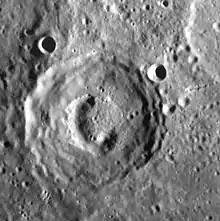 MESSENGER mosaic | |
| Planet | Mercury |
|---|---|
| Coordinates | 40°12′S 248°43′W / 40.20°S 248.71°W |
| Quadrangle | Neruda |
| Diameter | 60.0 km (37.3 mi) |
| Eponym | Clarice Beckett |

Another MESSENGER view
Beckett is a pit-floored crater on Mercury, which was discovered in January 2008 during the first flyby of the planet by the MESSENGER spacecraft.[1] The crater was named in November 2008 by the IAU.[2]
Its floor is not smooth and displays a telephone or arc-shaped collapse feature, which is also called a central pit. The size of the pit is 35 × 7.5 km.[3] Such a feature may have resulted from the collapse of a magma chamber underlying the central part of the crater[3] (see also Gibran and Picasso). The collapse feature is an analog of Earth's volcanic calderas.[4]
References
- ↑ "MESSENGER Views an Intriguing Crater". JHU/APL. January 20, 2008. Archived from the original on November 20, 2013. Retrieved November 18, 2009.
- ↑ Beckett, Gazetteer of Planetary Nomenclature, International Astronomical Union (IAU) Working Group for Planetary System Nomenclature (WGPSN)
- 1 2 Gillis-Davis, Jeffrey J.; Blewett, David T.; Gaskell, Robert W.; Denevi, Brett W.; Robinson, Mark S.; Strom, Robert G.; Solomon, Sean C.; Sprague, Ann L. (2009). "Pit-floor craters on Mercury: Evidence of near-surface igneous activity". Earth and Planetary Science Letters. 285 (3–4): 243–250. Bibcode:2009E&PSL.285..243G. doi:10.1016/j.epsl.2009.05.023.
- ↑ "A Newly Pictured Pit-Floor Crater". JHU/APL. September 30, 2009. Archived from the original on April 2, 2015. Retrieved November 18, 2009.
This article is issued from Wikipedia. The text is licensed under Creative Commons - Attribution - Sharealike. Additional terms may apply for the media files.